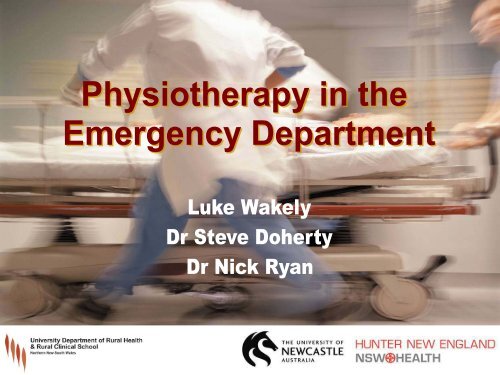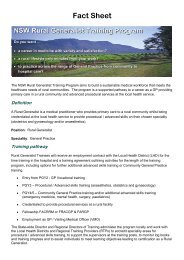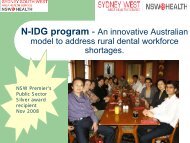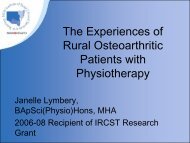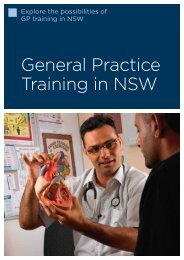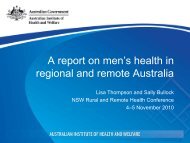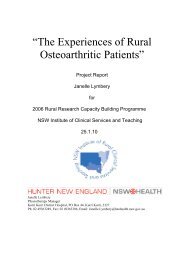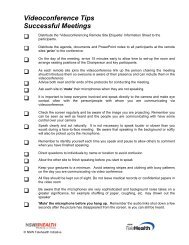Physiotherapy in the Emergency Department
Physiotherapy in the Emergency Department
Physiotherapy in the Emergency Department
Create successful ePaper yourself
Turn your PDF publications into a flip-book with our unique Google optimized e-Paper software.
Background<br />
• Physio’s relatively new <strong>in</strong> ED<br />
• Variety of models of care<br />
• Physio services have been shown to have a<br />
good effect on patient satisfaction<br />
(Be<strong>the</strong>l, 2005), (Anaf & Sheppard, 2007), (Kempson, 1996), (Lau et al, 2008)
Background<br />
• Physio’s do manage MS <strong>in</strong>juries differently<br />
to doctors and nurses (Ball et al, 2007)<br />
• Physio’s target areas that would normally<br />
impede discharge (Anaf et al, 2007)<br />
• Physio services have had a positive effect<br />
on wait<strong>in</strong>g times<br />
(Be<strong>the</strong>l, 2005), (Anaf & Sheppard, 2007), (Morris & Hawes, 1996)
Background<br />
• Position funded by UDRH & RCS<br />
• Aim:<br />
– Provide cl<strong>in</strong>ical service to Tamworth Hospital<br />
ED<br />
– Provide opportunities for cl<strong>in</strong>ical education for<br />
physio<strong>the</strong>rapy, medical, nurs<strong>in</strong>g and<br />
radiography students<br />
– Provide academic contribution to <strong>the</strong> UDRH &<br />
RCS
Role<br />
• Commenced <strong>in</strong> April 2009<br />
– 5 physio students completed ED cl<strong>in</strong>ical units.<br />
– Informal education of medical and nurs<strong>in</strong>g<br />
students.<br />
– Tutorials on management of MS conditions<br />
and paediatrics to medical and physio<br />
students.<br />
– Inservices to medical and nurs<strong>in</strong>g staff <strong>in</strong> ED
Cl<strong>in</strong>ical Role<br />
80%<br />
70%<br />
60%<br />
50%<br />
40%<br />
30%<br />
20%<br />
10%<br />
0%<br />
Soft Tissue Fractures O<strong>the</strong>r
Physio Patients<br />
300<br />
250<br />
200<br />
150<br />
100<br />
50<br />
0<br />
Patient Type<br />
C/Sp<strong>in</strong>e T/Sp L/Sp Lower Limb Upper Limb O<strong>the</strong>r
Cl<strong>in</strong>ical Role<br />
• 626 occasions of<br />
service.<br />
• 64% patients primary<br />
contact<br />
• 48% patients managed<br />
by a student under<br />
supervision.
Students<br />
• Physio students ga<strong>in</strong> experience treat<strong>in</strong>g<br />
conditions <strong>in</strong> a acute form.<br />
• Physio students ga<strong>in</strong> experience work<strong>in</strong>g <strong>in</strong> <strong>the</strong><br />
ED model of care.<br />
• Physio students ga<strong>in</strong><br />
experience <strong>in</strong> fracture<br />
management.
Students<br />
• All students have reported be<strong>in</strong>g satisfied or very<br />
satisfied overall with <strong>the</strong> placement.<br />
• All student reported now consider<strong>in</strong>g work<strong>in</strong>g <strong>in</strong><br />
a rural area upon graduation.<br />
• Students reported difficulty with travell<strong>in</strong>g costs<br />
and be<strong>in</strong>g away from sports & work dur<strong>in</strong>g<br />
placement
Students<br />
• Medical students taught cl<strong>in</strong>ical reason<strong>in</strong>g for<br />
musculoskeletal <strong>in</strong>juries<br />
• Medical students taught tap<strong>in</strong>g, plaster<strong>in</strong>g and<br />
exercise prescription.<br />
• Medical and physio students often work toge<strong>the</strong>r<br />
<strong>in</strong>terprofessionally.
Future Directions<br />
• Assess patient satisfaction and wait<strong>in</strong>g times.<br />
• Fur<strong>the</strong>r education for medical & nurs<strong>in</strong>g staff <strong>in</strong> ED.<br />
• Fund<strong>in</strong>g application for IPL unit <strong>in</strong> ED.
Future Directions<br />
• RCT on ankle spra<strong>in</strong> treatment.<br />
• Expand role with med, nurs<strong>in</strong>g and radiography<br />
students<br />
• Plan for physio student to spend a whole year <strong>in</strong><br />
Tamworth which would <strong>in</strong>clude an ED placement
Implications<br />
• Allied health practitioners can make significant<br />
contribution to patient care and <strong>the</strong> overall<br />
function<strong>in</strong>g of an emergency department.<br />
• In order to satisfy <strong>the</strong> demands for student<br />
placements <strong>in</strong>novative methods of cl<strong>in</strong>ical<br />
placement delivery must be utilised.
References<br />
Anaf, S. and L. A. Sheppard (2007). "Describ<strong>in</strong>g <strong>Physio<strong>the</strong>rapy</strong> Interventions <strong>in</strong> an <strong>Emergency</strong><br />
<strong>Department</strong> Sett<strong>in</strong>g: An Observational Pilot Study." Accident and <strong>Emergency</strong> Nurs<strong>in</strong>g 15: 34-39.<br />
Anaf, S. and L. A. Sheppard (2007). "<strong>Physio<strong>the</strong>rapy</strong> as a Cl<strong>in</strong>ical Service <strong>in</strong> <strong>Emergency</strong><br />
<strong>Department</strong>s: a Narrative Review." <strong>Physio<strong>the</strong>rapy</strong> 93(4): 243-252.<br />
Ball, S. T. E., K. Walton, et al. (2007). "Do <strong>Emergency</strong> <strong>Department</strong> <strong>Physio<strong>the</strong>rapy</strong> Practitioner's,<br />
<strong>Emergency</strong> Nurse Practitioners and Doctors Investigate, Treat and refer Patients with Closed<br />
Musculoskeletal Injuries Differently." <strong>Emergency</strong> Medic<strong>in</strong>e Journal 24: 185-188.<br />
Be<strong>the</strong>l, J. (2005). "The Role of <strong>the</strong> Physio<strong>the</strong>rapist Practitioner <strong>in</strong> <strong>Emergency</strong> <strong>Department</strong>s: A<br />
Critical Appraisal." <strong>Emergency</strong> Nurse 13(2): 529-549.<br />
Kempson, S. (1996). "<strong>Physio<strong>the</strong>rapy</strong> <strong>in</strong> an Accident and <strong>Emergency</strong> <strong>Department</strong>." Accident and<br />
<strong>Emergency</strong> Nurs<strong>in</strong>g 4(4): 198-202.<br />
Lau, P., D. Chow, et al. (2008). "Early <strong>Physio<strong>the</strong>rapy</strong> Intervention <strong>in</strong> an Accident and <strong>Emergency</strong><br />
<strong>Department</strong> Reduces Pa<strong>in</strong> and Improves Satisfaction for Patients with Acute Low Back Pa<strong>in</strong>: A<br />
Randomised Trial." Australian Journal of <strong>Physio<strong>the</strong>rapy</strong> 54(4): 243-9.<br />
Morris, C. and S. J. Hawes (1996). "The Value of Accident and <strong>Emergency</strong> Based <strong>Physio<strong>the</strong>rapy</strong><br />
Services." Journal of Accident and <strong>Emergency</strong> Medic<strong>in</strong>e 13: 111-113.


